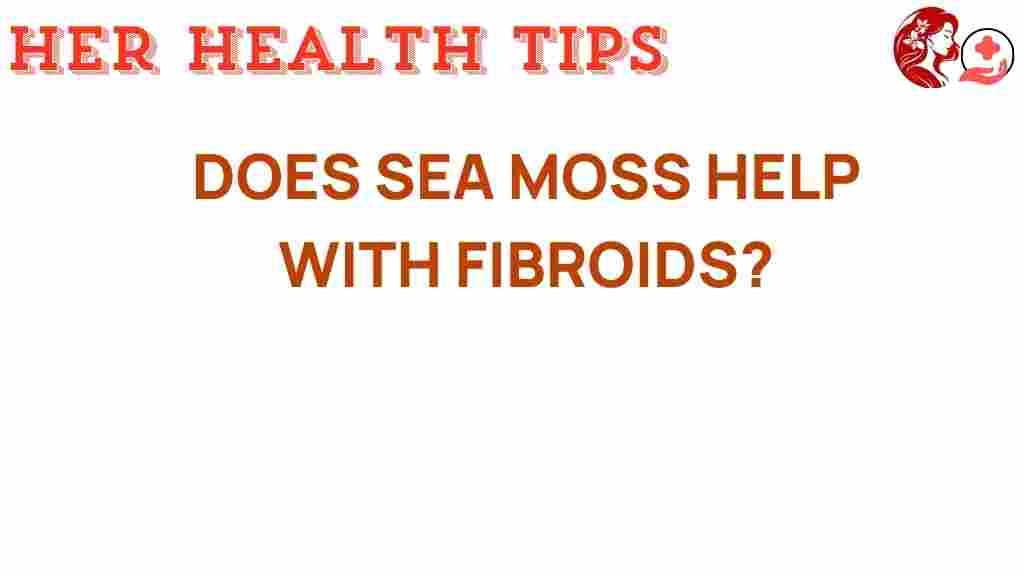The Surprising Role of Sea Moss in Managing Fibroids
Fibroids are non-cancerous growths that develop in or on the uterus, affecting a significant number of women worldwide. These growths can cause various health issues, including heavy menstrual bleeding, pelvic pain, and complications during pregnancy. As women search for effective ways to manage fibroids, many are turning to natural remedies. One such remedy that has gained popularity is sea moss, a nutrient-rich seaweed known for its numerous health benefits. In this article, we will explore the role of sea moss in managing fibroids, its health benefits, and how it fits into a holistic approach to women’s health.
What is Sea Moss?
Sea moss, also known as Irish moss or Chondrus crispus, is a type of red algae found along the Atlantic coasts of Europe and North America. It is rich in vitamins, minerals, and antioxidants, making it a popular choice in the wellness community. Sea moss is packed with essential nutrients such as:
- Iodine
- Calcium
- Magnesium
- Iron
- Zinc
- Vitamins A, C, E, and K
- Omega-3 fatty acids
These nutrients contribute to various health benefits, making sea moss a valuable addition to any diet, especially for women dealing with health issues such as fibroids.
Health Benefits of Sea Moss for Women’s Health
Incorporating sea moss into your diet can offer numerous health benefits, particularly for women. Here are some key benefits that relate specifically to managing fibroids:
- Hormonal Balance: Sea moss is known to support hormonal balance, which is crucial for women experiencing fibroids. It contains iodine, essential for thyroid function, which regulates hormones in the body.
- Anti-inflammatory Properties: Sea moss is rich in antioxidants and has anti-inflammatory properties, helping to reduce inflammation that can exacerbate fibroid symptoms.
- Nutrient Density: The high nutrient content of sea moss can assist in overall health and wellness, providing the body with the necessary tools to combat fibroid growth.
- Digestive Health: Sea moss acts as a natural prebiotic, promoting gut health and aiding digestion, which can be beneficial for women suffering from bloating or discomfort due to fibroids.
How to Incorporate Sea Moss into Your Diet
Adding sea moss to your diet can be simple and enjoyable. Here’s a step-by-step guide to incorporating this superfood into your meals:
Step 1: Choose Your Sea Moss
When selecting sea moss, opt for high-quality products that are organic and wildcrafted. You can find dried sea moss, powdered sea moss, or gel form in health food stores or online.
Step 2: Prepare the Sea Moss
If you choose dried sea moss, you’ll need to rehydrate it:
- Rinse the sea moss thoroughly to remove any debris or salt.
- Soak it in water for 12-24 hours, changing the water a couple of times.
- After soaking, drain and rinse again. Blend the sea moss with fresh water until you achieve a smooth gel-like consistency.
Step 3: Use Sea Moss Gel in Recipes
You can add sea moss gel to various recipes:
- Smoothies: Blend sea moss gel into your favorite smoothie for a nutrient boost.
- Soups and Stews: Stir in sea moss gel while cooking soups or stews for added thickness and nutrition.
- Salads: Use sea moss gel as a dressing base, mixing it with olive oil, lemon, and herbs.
Step 4: Dosage Recommendations
Start with 1-2 tablespoons of sea moss gel per day and adjust according to your body’s response. Always consult with a healthcare professional before adding new supplements to your routine.
Other Natural Remedies for Managing Fibroids
While sea moss can be beneficial, it’s often most effective when combined with other natural remedies. Here are some additional approaches to consider:
- Herbal Supplements: Consider herbal supplements like chaste tree or dandelion root, which may help balance hormones.
- Dietary Changes: A diet high in fruits, vegetables, whole grains, and lean proteins can support overall health and potentially reduce fibroid symptoms.
- Regular Exercise: Physical activity can help regulate hormones and improve circulation, which is beneficial for women with fibroids.
Troubleshooting Tips for Using Sea Moss
While sea moss is generally safe, some individuals may experience side effects or have questions about its use. Here are some troubleshooting tips:
- Digestive Issues: If you experience bloating or digestive discomfort, reduce your intake and gradually increase it as your body adjusts.
- Allergic Reactions: If you have a seafood allergy, consult your doctor before using sea moss, as it may cause allergic reactions in sensitive individuals.
- Interactions with Medications: Sea moss can interact with certain medications, particularly those affecting thyroid function. Always consult your healthcare provider.
The Importance of a Holistic Treatment Approach
Managing fibroids often requires a comprehensive approach that considers physical, emotional, and dietary factors. Incorporating sea moss into your routine can be part of a broader strategy that includes:
- Regular check-ups with your healthcare provider.
- Stress management techniques such as yoga or meditation.
- Support from a community or support group for women with similar experiences.
Taking a holistic view of women’s health encourages not only the management of fibroids but also overall wellness and vitality.
Conclusion
In conclusion, the surprising role of sea moss in managing fibroids highlights the potential of natural remedies in promoting women’s health. The rich nutrient profile of sea moss, combined with its health benefits, makes it an excellent addition to a holistic treatment plan. By incorporating sea moss into your diet and exploring other natural remedies, you can take proactive steps towards managing fibroids effectively. Always consult with a healthcare professional before starting any new supplement regimen to ensure it aligns with your health needs.
For more tips on improving your wellness through nutrition, check out our other articles on holistic health practices.
This article is in the category Reproductive and created by HerHealthTips Team
